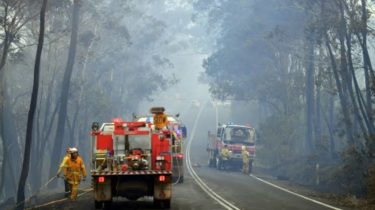As Heatwave fans bushfires Australia announces Highly sensitive situation

Most-crowded territory of New South Wales doing combating bushfires fuelled by dry season and extraordinary warmth, covering Sydney in exhaust cloud.
Australia set a precedent for its most sweltering day ever for a second in a row day with a normal national temperature of 41.9 degrees Celsius (107.4 Fahrenheit), a full degree higher than the past imprint.
The Bureau of Meteorology said on Thursday the new broadly arrived at the midpoint of most extreme was arrived at Wednesday, besting the 40.9 degrees hit Tuesday, which beat the past record of 40.3 C in January 2013.
The heatwave has exacerbated a phenomenal, dry spell powered arrangement of bushfires assaulting enormous territories of Australia.
As the heatwave proceeded with Thursday saw the most noteworthy December temperature at any point came to in Australia when the West Australian town of Eucla hit 49.8 degrees celsius (121.6 Fahrenheit).
The past most sweltering December day was 49.5 degrees celsius in Birdsville, Queensland, in 1972.
Experts in Australia on Thursday pronounced a seven-day highly sensitive situation in New South Wales, the second in as the same number of months, as a record heatwave fanned uncommon bushfires seething over the district.
Somewhere in the range of 100 flames have been consuming for a considerable length of time in the nation’s most crowded state. Half are uncontained, including a “super blast” ringing Sydney and covering Australia’s greatest city in a fog of poisonous smoke.
NSW Premier Gladys Berejiklian said the highly sensitive situation was because of “calamitous climate conditions”.
“The greatest worry throughout the following hardly any days is the unusualness, with extraordinary breeze conditions, incredibly hot temperatures,” Berejiklian told columnists in Sydney.
There are 2,000 firemen engaging the bursts with the help of groups from the United States and Canada just as the Australia Defense Force.
New South Wales Rural Fire Service Commissioner Shane Fitzsimmons said five 100-man “strike groups” were on reserve to convey to the most risky flames, “given the hugeness of a portion of these fire complexities and the seriousness of the figure climate conditions that are relied upon to unfurl all through today”.
“The most exceedingly awful of the fire climate conditions, the extraordinary fire threat appraisals we are anticipating today, are revolved around the more noteworthy Sydney condition,” they included.
Covered in smoke
The extraordinary climate is additionally causing huge wellbeing worries, with driving specialists this week marking the smoke murkiness covering Sydney a “general wellbeing crisis”.
In excess of 70 flames are additionally seething crosswise over Queensland state toward the north of New South Wales, including one at Peregian, close to the seaside visitor center of Noosa, that constrained individuals to escape their homes on Wednesday. Bushfires are additionally consuming in South Australia and Western Australia.
The flames have attacked in any event 3,000,000 hectares (7.4 million sections of land) of land crosswise over Australia as of late, with six individuals murdered and in excess of 800 homes wrecked.
Researchers state the bursts have come before and with more force than expected because of a worldwide temperature alteration and a delayed dry season that has left the land dry and numerous towns coming up short on water.
The flames have started atmosphere fights focused on the preservationist government, which has opposed the strain to address the main drivers of an Earth-wide temperature boost so as to ensure the nation’s rewarding coal send out industry.
Atmosphere dissenters intend to walk on Prime Minister Scott Morrison’s authentic living arrangement in Sydney to request controls on ozone depleting substance emanations and cause to notice their choice to occasion abroad occasion even as huge pieces of the nation consume.
Amber Wilson is working in England as a medical doctor. She has deep knowledge about medication, health, how to live well and genetics. She writes articles about that medication field as a part-time service which is required to needy people. In recent months, most of her writing has been in collaboration
Disclaimer: The views, suggestions, and opinions expressed here are the sole responsibility of the experts. No journalist was involved in the writing and production of this article.
